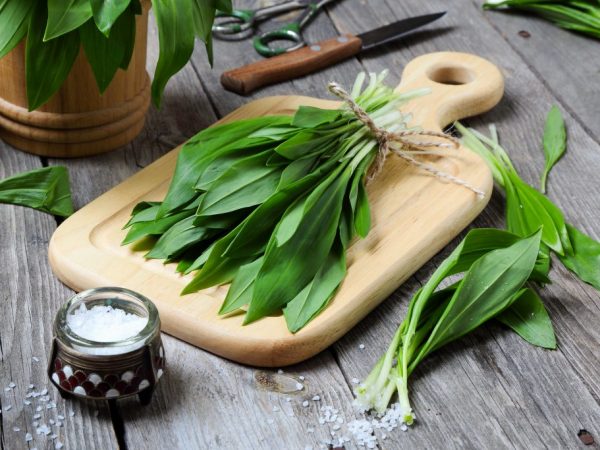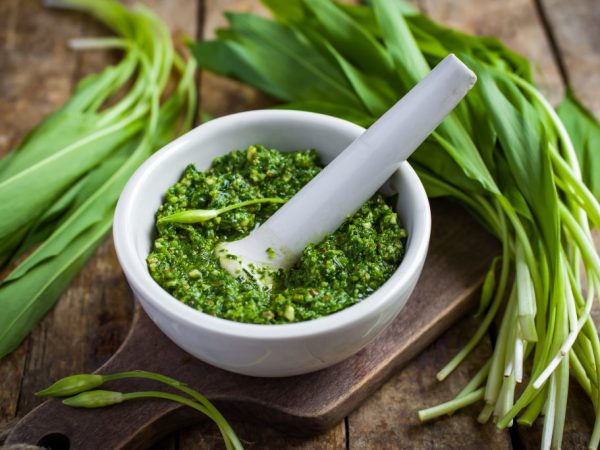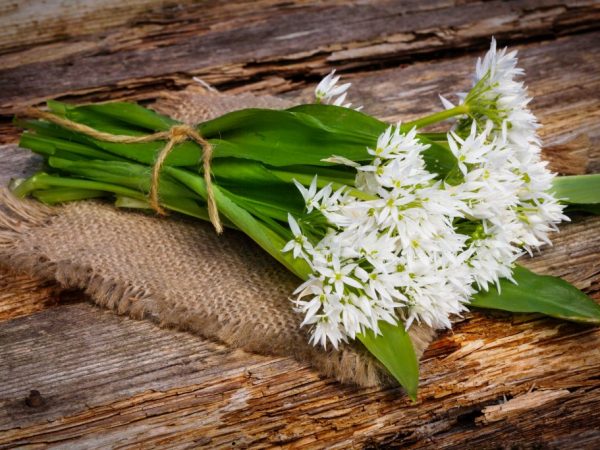Characteristics of Wild Garlic
In spring, small sprouts with a pleasant garlic aroma appear in many forests. This is nothing more than wild garlic. It grows in central Russia, as well as in America and Europe. You can meet him along the rivers or in the lowlands.

Characteristics of Wild Garlic
Ramson is famous for its high content of vitamins, and since it is the first greenery after the snow melts, including it in your diet, you can fight against spring hypovitaminosis.
Description of the plant
Wild garlic belongs to the onion subfamily and is a perennial herb. Some of its species are also called bear onions. This unusual plant has another name - dusai.
Appearance
Wild garlic grows up to 20-30 cm in height. Its leaves are elongated and are attached at the very base. The color of the leaves can vary from light green to dark. It depends on the age of the shoots. During flowering, wild garlic releases an arrow, on which fragrant white flowers appear in mid-May.
The underground part of a bear onion is a small bulb up to 5 cm in diameter. It is located quite close to the surface of the earth, and numerous long roots go deep into the depths, where they absorb water and nutrients dissolved in it.
Cooking applications
From April to mid-May, wild garlic can be harvested. At this time, it contains the maximum amount of vitamins, which means that using it is as high as possible, and the shoots themselves are still tender and juicy. After the beginning of flowering, they become tough and are not used for food.
It is best to consume wild garlic fresh. It is added to salads, pates, and appetizers. It is also salted and pickled in order to prepare useful greens for future use. Ramson is an invariable component of many national dishes. Kutaby - unleavened flatbread stuffed with greens, is traditionally prepared in the spring, when the forests and river estuaries are full of young wild garlic.
Forest garlic contains only 36 kcal per 100 g, which makes it a dietary product. It can be used by people watching their figure.
Agricultural applications
This unusual plant is eaten not only by people, but also by livestock. For cows and small ruminants, it gives wild garlic to normalize digestion and eliminate colic.
But you should be very careful with this plant. An excess of it in the animal's diet gives its meat a very specific taste. And milking cows, having tasted bear onions, produce yellowish milk with a pronounced garlic taste.
Properties of wild garlic
The main advantage of wild garlic is the presence of a large amount of vitamins and minerals in it. But, despite this, it can harm the human body.

Garlic is very healthy
Benefit
The composition of wild garlic is in many ways similar to garlic.Its spicy taste and aroma stimulates the production of gastric juice and increases salivation, which in turn stimulates the appetite. All this is due to the essential oils contained in the shoots of the plant.
Bear onions contain a huge list of vitamins and minerals:
- vitamins - A, PP, B1, B3, B6, B9, C;
- minerals - potassium, fluorine, sulfur, calcium;
- trace elements - iodine, iron, selenium, copper, boron, manganese, zinc, fluorine;
Among other things, wild garlic is rich in essential amino acids and omega fatty acids. It acts as an antiviral agent, due to its high content of vitamin C. It is also considered an excellent anti-sclerotic agent, and it also helps to remove toxins from the body.
Wild garlic is a diuretic and has a devastating effect on kidney and gallstones. It is also worth noting the fact that the substances contained in it help reduce pain in women during menstruation, as well as avoid headaches associated with them.
Vitamins PP, contained in young greens, helps to improve the functioning of the heart, and also lowers blood pressure. Wild garlic is also used to combat coughs. It helps to thin phlegm even with a chronic cough.
Harm
Despite this many health benefits, wild garlic can also be harmful. It is not recommended to use it for women during lactation, because breast milk may taste unpleasant and the baby will refuse to breastfeed. You can not eat it for people with an individual intolerance to the bear onion. This can lead to an allergic reaction and anaphylactic shock.
Wild garlic is contraindicated in people with the following diseases:
- stomach ulcer;
- gastritis during an exacerbation;
- pancreatitis;
- cholecystitis;
- hepatitis;
- intestinal inflammation.
Children are advised to give young shoots in moderation in order to avoid irritation of the esophageal mucosa and oral cavity. In a dried form, the plant cannot do harm, but it does not retain useful properties either.
How to grow wild garlic on the site
Not everyone and not always have the opportunity to go to nature for young shoots of bear onions. It can be successfully grown in your own garden. It's not so easy to do this, but it's worth a try.

Wild garlic is difficult to grow on site
Landing
Garlic can be planted with seeds, or you can bring adult plants by digging them up in their natural place of growth. The second option is simpler and gives almost 100% success, but if there are no such places nearby, then you will have to grow a plant from seeds.
Seed material can be purchased at any seed store. When buying, pay attention to the year of harvest The fact is that wild garlic germinates only the next year after ripening. If the seeds are stored longer, seedlings will not appear.
Seeds are sown in the fall in the ground or in February in seedling boxes. Crops require stratification, and if a sub-winter planting gives a natural drop in temperature, then in another case you will have to recreate it yourself. The container is covered with polyethylene and placed on the lower shelf of the refrigerator for 1.5 - 2 months.
After stratification, the seedling box is taken out of the cold and placed on the south window. Soon, the first shoots begin to break through the ground.
Care
Seedlings are kept in a warm place with high air humidity, if it is impossible to create such conditions, it is recommended to periodically spray the plants from a spray bottle. Excess moisture can cause mold to form on the soil surface. To avoid this, the soil is spilled with Fitosporin.
A week after the appearance of the first shoots, you need to feed them. To do this, use:
- superphosphate;
- ammonium nitrate;
- potassium sulfate.
After watering, it is recommended to gently push the soil in the pot. This can be done with a wooden stick or knitting needle. It is important not to touch the delicate roots of wild garlic.
Open ground transplant
At the end of April, the grown shoots of wild garlic are transplanted to a permanent place in open ground. You need to choose a site for planting with special care, since wild garlic grows quite quickly. One plant produces 5-7 new shoots annually. This can lead to the fact that it will be difficult to get rid of wild garlic thickets in the country.
When the place is chosen, you can start planting. Seedlings are separated and planted in shallow trenches. Previously, the beds can be fertilized with rotted manure and wood ash.
Conclusion
The benefits of wild garlic are undeniable. It is able to compensate for the lack of vitamins, minerals and trace elements, and also helps to fight many problems in the work of internal organs. But when collecting it in the forest, you should be extremely careful so as not to inadvertently pluck the lily of the valley, which is very reminiscent of wild garlic in the shape of a leaf. It is poisonous and can lead to severe intoxication of the body.
It does not matter where wild garlic grows, in the country or in the wild, its properties do not change from this. Another important point is that in some countries this plant is listed in the Red Book, and it is prohibited to pick it up in the forest belt.


